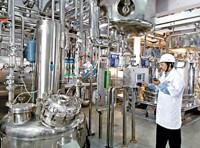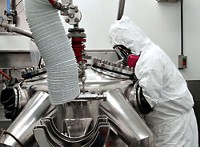Advertisement
Grab your lab coat. Let's get started
Welcome!
Welcome!
Create an account below to get 6 C&EN articles per month, receive newsletters and more - all free.
It seems this is your first time logging in online. Please enter the following information to continue.
As an ACS member you automatically get access to this site. All we need is few more details to create your reading experience.
Not you? Sign in with a different account.
Not you? Sign in with a different account.
ERROR 1
ERROR 1
ERROR 2
ERROR 2
ERROR 2
ERROR 2
ERROR 2
Password and Confirm password must match.
If you have an ACS member number, please enter it here so we can link this account to your membership. (optional)
ERROR 2
ACS values your privacy. By submitting your information, you are gaining access to C&EN and subscribing to our weekly newsletter. We use the information you provide to make your reading experience better, and we will never sell your data to third party members.
Specialty Chemicals
Is it India’s time in specialty chemicals?
Buyers’ desire to diversify beyond China could spur growth in India’s industry
by K. V. Venkatasubramanian, special to C&EN
September 4, 2020
| A version of this story appeared in
Volume 98, Issue 34

In 2017, several Indian and Chinese companies were competing to supply a polymer intermediate to a global chemical company. The deal was a lucrative one that would last for 20 years and require construction of a new plant. After a period of tough negotiations and careful site visits, the global firm awarded the contract to India’s Aarti Industries.
Watchers of the international trade scene may be surprised that the contract didn’t go to a Chinese company. After all, China’s low costs and manufacturing prowess have turned the country into a powerhouse exporter of all manner of industrial goods. But in India, people weren’t so surprised. In fact, Indian chemical executives are betting that they will increasingly win in the global marketplace.
Managers at Indian specialty chemical companies see a door opening for India. China has cracked down on environment scofflaws, forcing some small chemical makers there to shut down; US President Donald Trump is making it hard to do business with China through a combination of import tariffs and intellectual property prosecutions; and COVID-19 is making all chemical buyers rethink and diversify their supply chains.
Export opportunity
China is a bigger player than India in the top three specialty chemical export markets.
11%
China’s share of global pharmaceutical exports
4%
India’s share
17%
China’s share of agrochemical exports
6%
India’s share
12%
China’s share of dyes and pigments exports
5%
India’s share
Source: McKinsey & Co. based on data from IHS Markit and UN Comtrade
Such factors are prompting purchasing managers in the US, Europe, and Japan to give India another look as a source of raw materials for their chemical products. Still, India has many hurdles to clear—environmental, safety, logistical, and political—before it becomes a preferred chemical supplier around the globe.
Chemical manufacturing is one of India’s oldest and most diversified industries. And the country is a leader in certain segments. For example, India is a strong global dye supplier, accounting for nearly 16% of world production of dyes and dye intermediates, according to Invest India, a government agency.
In chemicals, India’s top export segment is specialty chemicals and top import segment is petrochemical intermediates, says a report published in February by the consulting firm McKinsey & Co. On balance, India faces a $15 billion-per-year trade deficit in chemicals.
“This deficit opens the door to two opportunities,” the report says. “Reducing imports of petrochemical intermediates could make India more self-sufficient and improve inputs for downstream specialty chemicals. And ramping up specialty chemicals exports could bring India a larger share of global value.”
Most observers agree that the biggest export opportunity for Indian chemical companies is in specialties. “The global merchant market for specialty chemicals is about $700 to 750 billion, and India exports just around 4% of it, while China has around 15% of the market. So there is lot of opportunity for Indian companies,” says Deepak Palekar, head of strategy and technology at the Indian consulting firm STEP.
Interest in India as an alternative to China spiked following supply disruptions that arose with the COVID-19 pandemic. But some firms have been looking to diversify for longer: Palekar says he’s been helping certain Japanese companies for more than 3 years to connect with Indian firms and reduce their dependence on China.
Indian executives are eager to take advantage of the moment. “An important factor in favor of Indian companies is their growing competitiveness vis-à-vis producers from other countries,” says Rajendra Gogri, chairman of Aarti Industries. He says Aarti won the 20-year supply contract with a combination of lower construction costs, robust quality practices, solid intellectual property protection, and an experienced team able to build and operate complex plants.
India has some inherent growth drivers, Gogri says, including a huge local demand base, significant exports with room to expand, and significant imports with scope for domestic substitution. “The growing per-capita income is raising living standards, which, when above $2,000, has been typically seen as an inflection point in the consumption of chemicals,” he says.
Sunil Chari, managing director of the Indian specialty chemical maker Rossari Biotech, concurs. He says one of the most important factors in favor of Indian companies today is their growth in domestic markets. “The shift in Western sourcing is still not big. But this will happen. Our growth is because of the growth in domestic markets.”
Rossari completed an initial public offering of stock on July 15 on India’s National and BSE stock exchanges.
Kalyan Madabhushi, head of the chemicals, fertilizers, and insulators business at the Indian conglomerate Aditya Birla Group, agrees that North American and European firms’ shift sourcing from China to India has yet to translate into significant sales.
“Western procurement and sourcing strategies, and corresponding supply chain infrastructure, were built across decades and will require time to readjust to the sourcing options that India could provide,” he says. “Industries in India would need to step up their game to be seen as competitive in terms of quality, cost, and agility.”
Indeed, several factors are working against Indian chemical companies as they try to grab a bigger spot on the world stage, among them costlier logistics due to inadequate infrastructure, limited raw material availability, and high power costs. “On the other hand,” Gogri says, “we have a lot of strengths in skilled and hardworking manpower, prolific process expertise, and lower capital and manpower costs.”
Although India has had some recent success in the export market, efforts to woo multinational firms to acquire businesses or build new plants—like they frequently do in China—have borne little fruit. Observers point mainly to two marquee projects: BASF’s participation in a propylene-based chemical complex in India, and Saudi Aramco’s proposed deal to buy into the petrochemical and refining business of the Indian conglomerate Reliance Industries. Both are still in the planning stages.
Most Indian companies are modest in size, with annual sales generally less than about $70 million, Palekar says. Such firms don’t have the capacity and capability to develop new production processes, he says. “Many of them are good copycats.” Only India’s larger companies, notably ones in the pharmaceutical industry, have the capability to develop new products and processes, he observes.
Another issue, Palekar says, is many small-and-medium-size Indian companies are family owned, and “they don’t want any ‘outsider,’ lest the owner or family lose control over the business.” Western investors generally want to take a majority stake, he says, to keep a grip on the business and bring in new technologies and products.
And regardless of ownership issues, many international executives are wary of India’s bureaucracy, knotty regulations, approval delays, poor infrastructure, and local political interference, Palekar says.
He points to just a handful of Western investment in specialty chemical operations in the past 3–5 years: Clariant’s acquisition of Vivimed Labs’ personal care business and investment in three firms—Sanmar Chemicals, ADI Finechem, and Privi Organics—by Fairfax India, an arm of the Canadian firm Fairfax Financial Holdings.
Beyond specialties, Indian companies active in pharmaceutical and agricultural chemical markets are doing well on their own and don’t seem interested in outside investments. “Dyes and intermediates is perceived as polluting, and hence there is generally no investor interest,” Palekar says. “Investors have shown interest in food additive, nutraceutical, and personal care companies, but many of them are small.”
Another concern for potential Western customers is a series of accidents in the recent past at chemical factories across India. The country has yet to come up with effective regulation for its chemical industry—even 36 years after the deadly leak of toxic gas from a chemical facility in Bhopal, India.
On May 7 of this year, styrene gas leaked from a storage tank on the premises of an LG Polymers unit in Visakhapatnam, killing 11 people and injuring hundreds of others. A panel set up to investigate the cause found the company to be negligent on 21 counts. It recommended a complete overhaul of local and federal safety regulations for factories.
If the Indian chemical industry is to fulfill its potential, Madabhushi says, companies need to benchmark themselves to international safety and sustainability standards. He says Aditya Birla has stringent targets in areas such as personal and process safety, carbon emissions, and water management.
India’s federal government positions itself as ready to support the shift from China to India in a range of industries. It has launched a scheme to push for indigenous manufacturing of pharmaceutical starting materials and active ingredients, many of which were made in India in years past.
To spur growth, India is setting up investment regions in the states of Andhra Pradesh, Gujarat, Odisha, and Tamil Nadu to provide infrastructure for the petroleum and chemical sectors. In addition, the government is establishing plastics production parks in several states.
Madabhushi expresses confidence that customer desire for supply chain diversification plus myriad other drivers will help India emerge as a competitive manufacturing hub in the coming decade.
Palekar, the consultant, is a little more circumspect. He acknowledges that firms in North America, Europe, Japan, and elsewhere want to diversify beyond China, but points out that replicating China’s investment in manufacturing infrastructure will take years and require billions of dollars. “It remains to be seen how much of it will turn into a reality in the next 2 to 3 years,” he says.
K. V. Venkatasubramanian is a freelancer based in Delhi.




Join the conversation
Contact the reporter
Submit a Letter to the Editor for publication
Engage with us on Twitter